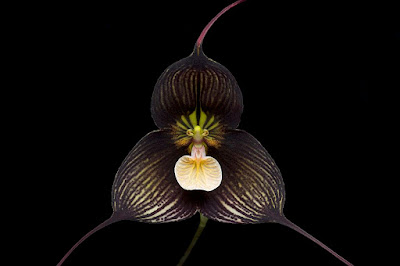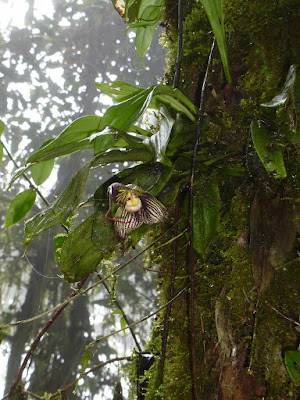Dracula vampira is native to Ecuador. These plants are found only in mountain rain forests at an altitude of 1800-2200 m, on the western slopes of Mt. Pichincha in the province of Pichincha. Although their occurrence is limited, they are not rare plants in nature...
Dracula vampira also called as The Vampire-Like Dracula, Masdevallia vampira, is a species of the genus Dracula. This species was described by Carlyle A. Luer in 1978.
IDENTIFY DRACULA VAMPIRA
Dracula vampira is native to Ecuador. These plants are found only in mountain rain forests at an altitude of 1800-2200 m, on the western slopes of Mt. Pichincha in the province of Pichincha. Although their occurrence is limited, they are not rare plants in nature. Many of these plants can be found in damp, leafy litter on the lower parts of huge trees covered with epiphytes.
It is a medium sized, cool to cold growing epiphyte, which reaching 19-34 cm in height, with clustered, erect, 4-6 cm long ramicauls enveloped by 2 to 3 close, truncate, tubular sheaths carrying a single, apical, erect, elliptic-obovate, acute, gradually narrowing below into the conduplicate, petiolate base, 15-28 cm long and 4.0-5.5 cm wide leaf.
The Vampire-Like Dracula blooms at most any time of the year has a basal, pendant to horizontal, 37 to 57 cm long, laxly successively single, several flowered inflorescence with obliquely tubular bracts and up to 6, showy, pendant flowers. The flowers are 8 cm in diameter. A characteristic feature of this species are the large, widely spread petals of the external whorl. The basic color of the outer whale petals is greenish, almost completely covered by numerous thin, more or less parallel, oblong, black and purple veins that converge at the ends. The small, white petals of the inner whorl have purple spots. The lip is white with pinkish to yellowish veins and the prone is yellow.
DRACULA VAMPIRA CARE AND CULTURE
Cultural information should only be used as a guide, and should be to be adapted to suit you. Your physical location; where you grow your plants, how much time you have to devote to their care, and many other factors, will need to be taken into account. Only then can you decide on the cultural methods that best suit you and your plants.
Light:
Dracula vampira needs a light level of 12000-18000 lux. These plants should grow in the shade, the light should be filtered and dispersed, and the plants should never be exposed to direct sunlight. Strong air movement should be ensured all the time. If the plants do not flower, the dose should be gradually increased, taking care not to burn the leaves.
Temperature:
It is a plant with moderate to cold thermal requirements. Similar throughout the year, the average temperatures is 25-27 ° C, average night temperatures 12-13 ° C, with an amplitude of daily variations of 11-16 ° C.
Humidity:
The Vampire-Like Dracula needs the humidity of around 70-75% throughout the year.
Substrate, growing media and repotting:
Dracula vampira must be grown mounted on washers or in openwork hanging baskets with high humidity, and in the summer of daily watering. In the case of such suspended plants, during the dry and hot periods it may be necessary to water several times a day.
You can also use hanging moss-covered sphagnum moss filled with loose, fast-drying ground, such as medium granulation fir bark or chopped tree fern fibers. Also, materials that release the substrate but often retain a part of the moisture are often added to the mixture, for example perlite and cut sphagnum moss. Wood charcoal is also often added to ensure the air permeability of the substrate and protection against acidification.
The plants grown in it must be replanted every 9-12 months. Plants should be replanted when the substrate begins to decompose or grow out of the pots. If replanting is done at the time when new roots begin to appear, the plant will be accepted and rooted in the shortest possible time.
Watering:
Rainfall is moderate and even abundant, from the end of spring to autumn and only during 2-3 winter months are relatively small. During intensive growth, the plants should be watered profusely, but the substrate should not be allowed to spread or become damp. When new growths reach maturity in the autumn, the amount of water should be gradually reduced.
Fertilizer:
During the active growth, the plants should be fertilized every week 1/4-1/2 of the recommended dose of fertilizer for orchids. You can use balanced fertilizer throughout the year, but also can use fertilizer with increased nitrogen content from spring to mid summer, and then in the late summer and autumn, use a fertilizer with a higher content of phosphorus.
Rest period:
In winter, if the Dracula vampira are grown under the conditions of a dark, short day characteristic of moderate latitudes, the watering needs to be slightly reduced, but it can not be allowed to dry completely. Fertilization should be reduced or eliminated until new growths appear in the spring and more abundant watering starts.

















COMMENTS